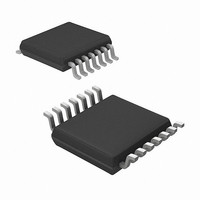MRF49XA-I/ST Microchip Technology, MRF49XA-I/ST Datasheet - Page 56

MRF49XA-I/ST
Manufacturer Part Number
MRF49XA-I/ST
Description
IC RF TXRX 433/868/915 16-TSSOP
Manufacturer
Microchip Technology
Datasheet
1.MRF49XA-IST.pdf
(102 pages)
Specifications of MRF49XA-I/ST
Package / Case
16-TSSOP
Frequency
433MHz, 868MHz, 915MHz
Data Rate - Maximum
256kbps
Modulation Or Protocol
FHSS, FSK
Applications
Home / Industrial Automation, Remote Access, Security Alarms
Power - Output
7dbm
Sensitivity
-110dBm
Voltage - Supply
2.2 V ~ 3.8 V
Current - Receiving
11mA
Current - Transmitting
15mA
Data Interface
PCB, Surface Mount
Antenna Connector
PCB, Surface Mount
Operating Temperature
-40°C ~ 85°C
Number Of Receivers
1
Number Of Transmitters
2
Wireless Frequency
433 MHz to 915 MHz
Output Power
+ 7 dBm
Operating Supply Voltage
2.5 V, 3.3 V
Maximum Operating Temperature
+ 85 C
Mounting Style
SMD/SMT
Minimum Operating Temperature
- 40 C
Modulation
FHSS, FSK
Lead Free Status / RoHS Status
Lead free / RoHS Compliant
Memory Size
-
Lead Free Status / Rohs Status
Lead free / RoHS Compliant
Other names
579-MRF49XA-1/ST
Available stocks
Company
Part Number
Manufacturer
Quantity
Price
Company:
Part Number:
MRF49XA-I/ST
Manufacturer:
IR
Quantity:
450
Part Number:
MRF49XA-I/ST
Manufacturer:
MICROCHIP/微芯
Quantity:
20 000
3.10
The baseband receiver has several programming
options to optimize the communication for a wide range
of applications. The programmable functions are as
follows:
• Baseband Analog Filter
• Baseband Digital Filter
• Receive Bandwidth
• Receive Data Rate
• Clock Recovery
FIGURE 3-8:
The receive bandwidth is programmable from 67 kHz
to 400 kHz to accommodate various FSK modulation
deviations. If the deviation is known for a given trans-
mitter, good results are obtained with a bandwidth of at
least twice the transmitter FSK deviation.
EXAMPLE 3-1:
DS70590B-page 54
MRF49XA
• Data Rate – 9.6 kbps
• Crystal Accuracy – 40 ppm
• Frequency Band – 915 MHz
• f
Deviation = Data Rate + 2 x f
The closest possible deviation is 90 kHz.
BBBW = Deviation x 2 – 10 kHz = 90 x 2 – 10 = 170 kHz
The closest possible BBBW is 200 kHz.
The FSK modulated deviation for this example is shown in Figure 3-9.
xerror
by the Crystal: 40 x (915000/1000000) = 36.6 kHz
Baseband/Data Filtering
-100
-120
-140
FULL BASEBAND AMPLIFIER TRANSFER FUNCTION (BW = 67 kHz)
FREQUENCY DEVIATION AND BBBW CALCULATION
-20
-40
-60
-80
40
20
1.0E+02
0
xerror
+ 10 = 9.6 + 2 x 36.6 + 10 = 92.8 kHz
1.0E+03
Preliminary
Frequency (Hz)
1.0E+04
A suitable bandwidth should be used to achieve various
FSK deviation, data rate and crystal tolerance require-
ments. The filter structure is a 7th order, Butterworth
low-pass with 40 dB suppression at twice the bandwidth
frequency. Offset cancellation is done by using a
high-pass filter, with a cutoff frequency below 7 kHz, in
order to achieve the best possible frequency response in
baseband and a good flat response in the pass band.
Figure 3-8 shows the full baseband amplifier transfer
function This optimizes the chip area, cost and channel
separation.
Example 3-1 shows the method to calculate the recom-
mended frequency deviation and BBBW for the given
specifications.
1.0E+05
© 2009 Microchip Technology Inc.
1.0E+06












